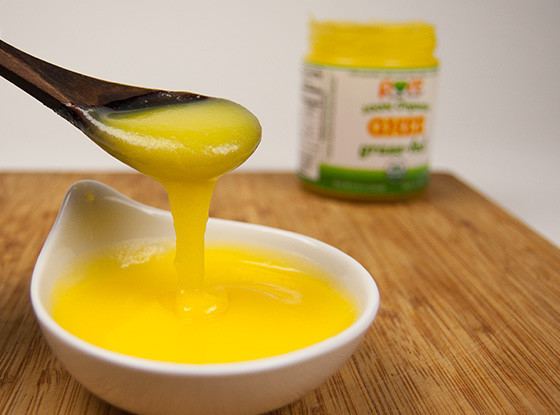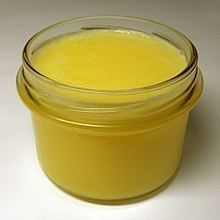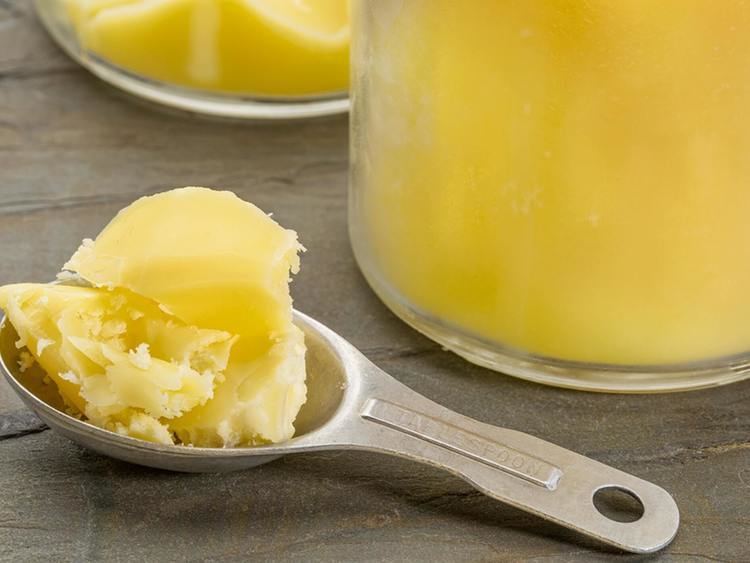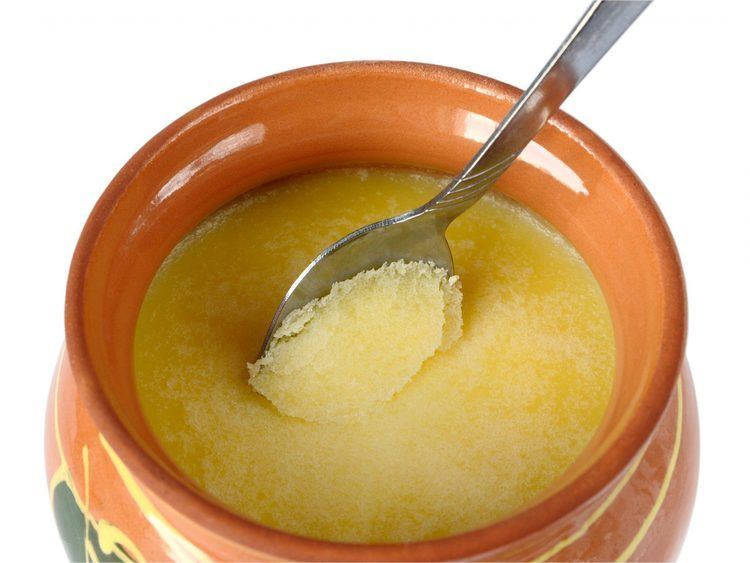Saturated 7.926 g Polyunsaturated 0.473 g Potassium 1 mg (per 1 tablespoon) | Monounsaturated 3.678 g Protein 40 mg (per 1 tablespoon) | |
 | ||
Energy 112.1 Calories (per 1 tablespoon) Fat 12.73 g (per 1 tablespoon) Similar Butter, Dal, clarified butter, Paneer, Masala | ||
Ghee clarified butter easy
Ghee is a class of clarified butter that originated in ancient India and is commonly used in South Asian, Iranian and Arabic cuisines, traditional medicine, and religious rituals.
Contents
- Ghee clarified butter easy
- Organic desi ghee clarified butter poonam s kitchen
- Description
- In Hinduism
- Culinary uses
- Clarified butter vs ghee
- Traditional medicine
- Nutrition
- Outside the Indian subcontinent
- Etymology and other names
- Market
- References

Organic desi ghee clarified butter poonam s kitchen
Description

Ghee is prepared by simmering butter, which is churned from cream, skimming any impurities from the surface, and then pouring and retaining the clear, still liquid fat, while discarding the solid residue that settled on the bottom. Spices can be added for flavor. The texture, color, and taste of ghee depend on the quality of the butter, source of the milk used in the process and the duration of the boiling.
In Hinduism

Traditionally, ghee Sanskrit: गोघृत, go-ghṛta is always made from the milk of cows, which are considered sacred, and it is a sacred requirement in Vedic yajña and homa (fire sacrifices), through the medium of Agni (fire) to offer oblations to various deities. (See Yajurveda).

Fire sacrifices have been performed dating back over 5,000 years. They are thought to be auspicious for ceremonies such as marriage, funerals, etc. Ghee is also necessary in Vedic worship of mūrtis (divine deities), with aarti (offering of ghee lamp) called diyā or Dīpa and for PañCāmṛta (Panchamruta) where ghee along with mishri (mishri is different from sugar), honey, milk, and dahī (curd) is used for bathing the deities on the appearance day of Krishna on Janmashtami, Śiva (Shiva) on Mahā-śivarātrī (Maha Shivaratri). There is a hymn to ghee.
In the Mahabharata, the kaurava were born from pots of ghee. Finding ghee pure enough to use for sacred purposes is a problem these days for devout Hindus, since many large-scale producers add salt to their product. Ghee is also used in bhang in order to heat the cannabis to cause decarboxylation, making the drink psychoactive.
Culinary uses
Ghee is common in Indian and Pakistani cuisine, including traditional rice preparations (such as biryani). In Rajasthan, ghee often accompanies baati. All over north India, ghee tops roti. In Bengal (both West Bengal and Bangladesh) and Gujarat, khichdi is a traditional evening meal of rice with lentils, cooked in curry made from yogurt, cumin seeds, curry leaves, cornflour, turmeric, garlic, salt and ghee. It is also an ingredient in kadhi and Indian sweets, such as Mysore pak and varieties of halva and laddu. Pakistani and Punjabi restaurants typically incorporate large amounts of ghee, sometimes brushing naan and roti with it, either during preparation or just before serving.Ghee is widely used in south indian cuisine for tempering curries , in preparation of rice dishes and sweets. South Indians have a habit of adding ghee to their rice before eating it with pickles and curries. South Indians are one of the biggest consumers of Ghee. the people from Telangana and Andhra Pradesh especially use ghee for preparation of savoury and sweet dishes alike. Ghee is important to traditional Punjabi cuisine, with parathas, daals and curries often using ghee instead of oil for a richer taste. The type of ghee, in terms of animal source, tends to vary with the dish; for example, cow's milk ghee(Bengali: গাওয়া ঘী, gaoa ghi) is traditional with rice or roti or as a finishing drizzle atop a curry or daal (lentils) whereas buffalo-milk ghee is more typical for general cooking purposes.
Ghee is an ideal fat for deep frying because its smoke point (where its molecules begin to break down) is 250 °C (482 °F), which is well above typical cooking temperatures of around 200 °C (392 °F) and above that of most vegetable oils.
Clarified butter vs. ghee
Ghee differs slightly in its production. The process of creating traditional clarified butter is complete once the water is evaporated and the Fat (clarified butter) is separated from the milk solids. However, the production of ghee includes simmering the butter, which makes it nutty-tasting and aromatic.
A traditional Ayurvedic recipe for ghee is to boil raw milk, let it cool to 110 °F (43 °C),. After letting it sit covered at room temperature for around 12 hours, add a bit of yogurt to it and let it sit overnight. This makes more yogurt. This is churned with water, to obtain cultured butter, which is used to simmer into ghee.
Traditional medicine
Ayurveda considers pure un-adulterated ghee to be sāttvik or sattva-guṇi (in the "mode of goodness"), when used as food. It is the main ingredient in some of the Ayurvedic medicines, and is included under catuh mahā sneha (the four main oils: ghṛta, taila, vasā, and majjā) along with sesame oil, muscle fat, and bone marrow. Ghee is used preferentially for diseases caused by Pitta Dosha. Many Ayurvedic formulations contain ghee, for example, Brāhmi ghṛta, Indukānta ghṛta, Phala ghṛta, etc. Though eight types of ghee are mentioned in Ayurvedic classics, ghee made of human breast milk and cow's ghee are claimed to be excellent among them. Further, cow's ghee has medhya (intellect promoting) and rasāyana (vitalizing) properties. Ghee is also used in Ayurvedas for constipation and ulcers. Vechur cow Ghee produced using Vechur cow’s milk, is famous for its high medicinal values due to the presence of A2 beta-lactalbumin Protein and higher arginine content which is good for the health of convalescing people.
In Sri Lankan indigenous medical traditions (Deshīya Cikitsā), ghee is included in pas tel (five oils: ghee, margosa oil, sesame oil, castor oil, and butter tree oil).
Nutrition
Like any clarified butter, ghee is composed almost entirely of fat, 62% of which consists of saturated fats; the nutrition facts label found on bottled cow's ghee produced in the United States indicates 8 mg of Cholesterol per teaspoon.
Indian restaurants and some households may use partially hydrogenated vegetable oil (also known as vanaspati, dalda, or "vegetable ghee") in place of ghee because of its lower cost. This "vegetable ghee" may contain trans fat. Trans fats have been shown to increase the risk of coronary heart disease even more so than Saturated fats. The term shuddh ghee, however, is not used in many regions as partially hydrogenated oils are marketed as pure ghee in some areas. In India, the sale of fake ghee is stopped by law enforcement agencies whenever a complaint is made. Ghee is also sometimes called desi (country-made) ghee or asli (genuine) ghee to distinguish it from "vegetable ghee".
Outside the Indian subcontinent
Several communities outside the Indian subcontinent make ghee. Egyptians make a product called samna baladi (سمنة بلدى IPA: [ˈsæmnæ ˈbælædi], meaning "local ghee"; i.e., Egyptian ghee) identical to ghee in terms of process and result, but made from water buffalo milk instead of cow milk, and white in color. Also, during the process, the darkened milk solids are considered a delicacy called morta مرطة, which is a salty condiment used sparingly as a spread, or as an addition on fava dishes. Regular samna is also made from cow milk in Egypt and is often yellowish.
Tesmi (in Tigrinya language) is the clarified butter prepared in the country of Eritrea. The preparation is similar to that of ghee but the butter is oftentimes combined with garlic and other spices found native to the area. Tesmi is staple ingredient in Eritrean cuisine. In Ethiopia, niter kibbeh (Amharic: ንጥር ቅቤ niṭer ḳibē?) is made and used in much the same way as ghee, but with spices added during the process that result in distinctive tastes.
In North Africa, Maghrebis take this one step further, aging spiced ghee for months or even years, resulting in a product called smen (oedie in the Amazigh language).
In northeastern Brazil, an unrefrigerated butter very similar to ghee, called manteiga-de-garrafa (butter-in-a-bottle) or Manteiga-da-terra (butter of the land), is common.
Ghee is widely used in Europe. For example, Wiener Schnitzel is traditionally fried in a version of ghee known as Butterschmalz. In Switzerland as well as bordering areas, butter was rendered in the old days to preserve the product for several months without refrigeration. "Boiled Butter", as it is commonly called, is used extensively to finish a typical dish of roesti, the Swiss version of hash browns. It gives the dish its distinct flavor. This product is also used in baking of various pastries and cakes as a substitute for fresh butter to enhance the flavor of the products.
Among Nilotic pastoralist communities in the African Great Lakes region, such as the Nandi, Tugen, and Maasai communities, ghee and flocculated byproducts (kamaek) from ghee-making were traditionally used as cooking oil.
In Japan, ghee was mentioned in the Nirvana Sutra, and inspired the creation of Daigo, created from so, a milk skin cheese.
Etymology and other names
The word ghee comes from Sanskrit: घृत (ghṛta, IPA: [ɡʱr̩t̪ə] 'sprinkled') and has several names around the world (Marathi/Konkani: तूप tūp, Bengali: ঘি ghi, Punjabi: ਘਿਓ ghio, Hindi: घी ghī, Gujarati: ઘી ghi, Maithili/Nepali: घ्यू ghyū, Urdu: گھی ghī, Odia: ଘିଅ ghiô, Kannada: ತುಪ್ಪ tuppa, Malayalam: നെയ്യ് neyy, Tamil: நெய் ney, Sinhalese: Ela-ghitel or Ghitel එලඟි තෙල් or ගිතෙල්, Telugu: నెయ్యి neyyi, Somali: subag, Arabic: سمن samn, Pashto language: غوړي ġhwaṛee, Azerbaijani: Sarı yağ, Persian: روغن حیوانی - روغن کرمانشاهی roghan-e heiwâni, Kurdish: ڕۊنِ دان řün-i Dan, Georgian: ერბო erbo, Indonesian: minyak samin, Malay: minyak sapi, Hausa: man shanu).samuli in maasai language
Market
The market size of ghee in India is 10,000 crores as of 2016. India is the world’s largest producer of buffalo and cow milk and consequently also the largest producer and consumer of ghee.
